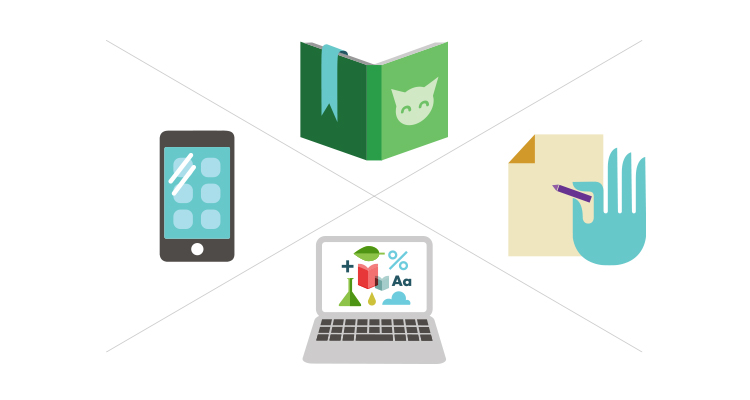Using Instagram as a Learning Opportunity
Do you use Instagram? This free photo-sharing app is one of the fastest growing social networks, with 100 million users, and it’s easy to see why. With its retro square format and lo-fi filters, the app makes shooting, editing, and sharing photos easy and fun. And now you can follow K12 on Instagram! Check out photos from community events at our partner schools around the country, peek behind the scenes at K12 for a preview of what we’re working on, and share your online schooling photos with us by tagging us @k12learn.
Instagram is fun and social, but lately I’ve been wondering if there are also potential learning opportunities for users. With 1 million kids ages 12-17 using Instagram in a given month, it’s apparent that kids love the app’s social photo-sharing capabilities. But is it possible to channel that enthusiasm into learning?
One of the benefits to using social media in school is that students may be more engaged in their work when they feel they have an authentic audience– that someone other than their teachers will see it. Just as with blogging and tweeting, Instagram is a social sharing application, so the authentic audience is definitely there.
In order to sign up for an account, users do need to be 13 – just like with Facebook. Although it might look like a simple camera app, Instagram is a social network, and the same privacy precautions that should be taken on Facebook and Twitter also apply here. Instagram does allow private profiles so that only approved users can view photos, For younger kids and tweens, it may be a good idea to only allow friends and family to follow. If your kids use the app, or would like to, talk with them about internet safety: what kinds of pictures are OK to share, whether or not to accept friend requests from people they don’t know, and what kinds of comments are appropriate to make (i.e., if you wouldn’t say it to someone’s face, don’t say it in a comment.)
While it is important to be careful with any social network, I do think that there are benefits and a real potential for using Instagram in learning. One positive side effect I’ve noticed since I began using the app is that I pay more attention to my surroundings and the many picture-perfect opportunities that occur every day. Although Facebook and Twitter also have photosharing capabilities, something about the Instagram community and format seems to inspire me to think more like a photographer and notice everyday beauty around me. Along with encouraging kids to pay attention to details, some possibilities for using Instagram with students might include:
- Encouraging early descriptive writing– Recently I came across a blog post from a teacher who has been successfully using Instagram with his kindergarten class. The students snap pictures of their favorite things, like a tree or a favorite toy, and practice writing a sentence or two about that thing. For privacy reasons, the teacher created one class Instagram account for all the students to use, and set it to private so only approved followers (parents and other classes) can see the photos. For teachers and parents who would like to try using Instagram with younger students, sharing an account may be a good way to go.
- Art and photography class- Fairly obvious, yes, but iPhoneography is becoming more popular (and practical) than ever. As they say, the best camera is the one you have with you. As cameras on mobile phones improve, and sophisticated editing apps make it possible to do more, some photographers have suggested a phone loaded with the right apps could be the only camera the amateur photographer would ever need. The same rules of lighting and composition apply to camera photography, but the lack of complex settings can make it easier for kids to focus on photo composition. Students can easily share their work and view and comment on their classmates’ photos.
- Photo journaling Here’s a great idea from a teacher featured in this Infinite Thinking Machine video. She uses Instagram and Twitter with her class to encourage critical thinking and communication skills. Kids snap pictures throughout the day and write short descriptions of them. hoto journaling in 140 characters is an excellent way to practice clear, concise writing.
- Writing prompts In addition to being a place to share your own photos, Instagram can provide a wealth of inspiration. Many talented professional photographers use the app to share amazing photos. Students or teachers can snap their own picture, or choose an interesting one from another photographer to use as a prompt for creative, descriptive, or narrative writing.
- Showing a sequence Use Instagram and a photo collage app like Diptic or PicStitch to show a sequence of events or steps in a how to procedure. Kids can expand on the process in the comments.
- Observing change– Use Instagram to visually document change over time. Track weather patterns, the growth of a pet, or the stages of plant growth.
- Practicing the ABCs Take pictures of visually interesting letters in the real world to make an Instagram alphabet book. Or look for objects with names corresponding to each alphabet sound.
- Real world math– Document examples of math in the real world: shapes, fractions, patterns, parallel lines, curves, etc. that occur in our environment, both naturally and manmade.
If you’re not sure how to get started with Instagram, check out this blog post from the Edublogger for a thorough, informative guide to using the app. And don’t forget to follow K12!





































